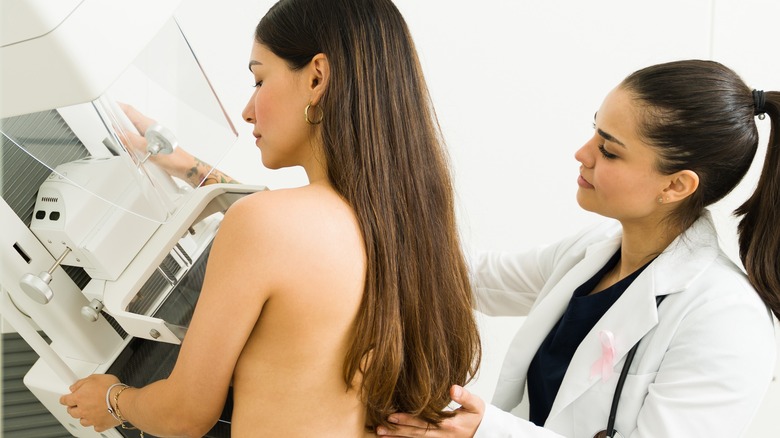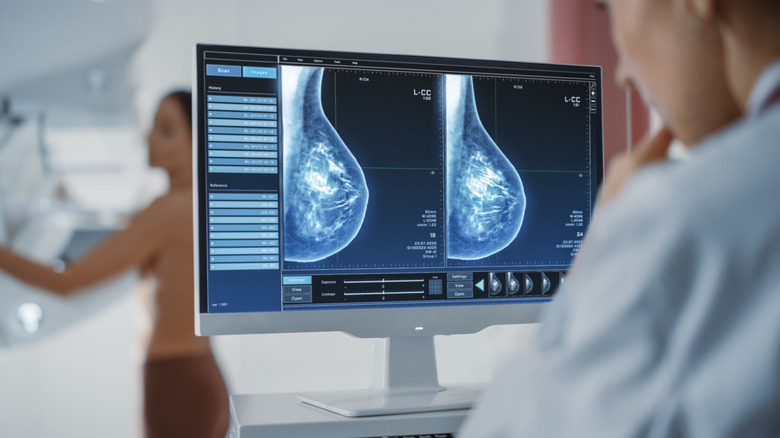7 Reasons To Request A Mammogram
Getting a mammogram can be an extremely important step in identifying early signs of breast cancer. According to the Centers for Disease Control and Prevention (CDC), a mammogram is an X-ray picture of the breast, and, in some cases, can even find breast cancer up to three years before it's felt. A mammogram will show some changes in the breast such as calcifications, masses, asymmetries, and distortions, per the American Cancer Society (ACS).
When you get a mammogram, you'll take your shirt and bra off, place each breast on a plastic platform, and the technician will flatten them out to find any tumors or other signs of breast cancer (per ACS). You don't need to have any symptoms of breast cancer to get a mammogram. In fact, generally speaking, if you're at average risk of breast cancer, you may want to consider getting an annual mammogram at age 45. You should definitely begin receiving mammograms starting at 50 (via ACS).
There are several different scenarios where you should request getting a mammogram prior to turning 45, though. Typically, this will be if you're at a higher risk of developing breast cancer, as stated by Healthline. The Breast Cancer Foundation notes that people at a higher risk will sometimes include those with a personal or family history of breast cancer or ductal carcinoma in situ (DCIS). Read on to find out other situations where you should consider getting a mammogram ahead of turning 45.
If you're someone with a higher than average risk of developing breast cancer
There are several levels of risk for breast cancer. According to the Breast Cancer Foundation, you can be at an increased, decreased, or average risk of breast cancer. Characteristics linked to a decreased risk can include breastfeeding, being physically active, and maintaining a healthy weight.
However, the Foundation also notes that people who are at a higher risk include a wide range of factors, with being female the top one. Men can still get breast cancer, but it's around 100 times more common in women. Other people who are at high risk are those who have close relatives that had breast cancer, those with BRCA gene mutations (BRCA1 or BRCA2), and a family history of breast cancer (via Healthline).
Age can also heighten your risk. As stated by the Breast Cancer Foundation, breast cancer rates in women start to increase at 40 and are highest in women who are over 70 years old. The median age of men in the U.S. with breast cancer is 68.
You're between 50 and 74 years old and are at average risk of breast cancer
Although you can begin getting annual mammograms at age 40, if you're at average risk of developing breast cancer, it's fine to start at 45 (via ACS).
However, even if you're at an average risk (this means that you don't have any high risk factors), there are some characteristics that increase your risk and can't be changed. As stated by the CDC, these factors include getting older and your reproductive history. If you started your period before age 12 or began menopause after 55, the risk for breast cancer is increased.
According to the U.S. Preventive Services Task Force (USPSTF), it's recommended to begin biennial mammograms for those aged 50 to 74 if you're at average risk. Additionally, the USPSTF notes that for people who are at average risk, there's really no need to start getting mammograms in your 40s, since they can often lead to false positives and unnecessary biopsies.
You have dense breasts
According to the National Cancer Institute, dense breasts are defined by having high amounts of glandular and fibrous connective tissue and low amounts of fatty breast tissue. Incidentally, the only way to find out if you have dense breasts is by getting a mammogram, which can show whether the breasts are fatty, scattered, heterogeneously dense, or extremely dense.
The Mayo Clinic explains that dense breasts are common, but they're also a risk factor for developing breast cancer. There aren't any definitive causes of dense breasts, but some commonalities include younger age, a lower body mass index (BMI), and taking hormone therapy for menopausal symptoms.
As stated by BreastCancer.org, dense breasts can make it harder for doctors to see breast cancer on mammograms, increasing the risk of missing abnormalities. Additionally, research has shown that people with dense breasts have a generally higher risk of developing breast cancer.
You find a lump that doesn't go away
It's super important to do regular self-breast exams or have clinical breast exams (CBEs) performed. According to the Mayo Clinic, a breast self exam can help you identify any new changes regarding shape or size.
Lumps or changes in your breasts can sometimes be normal, especially throughout your menstrual cycle. However, you should make an appointment to see your doctor if you notice a hard lump or knot near your underarm, see changes in the way your breasts look or feel, notice dimpling, puckers, bulges, or bloody nipple discharge. If your doctor performs a CBE and notes abnormal results, you'll likely have follow-up tests, which may include a mammogram or breast ultrasound, as stated by the Breast Cancer Foundation.
That being said, finding a lump doesn't always mean it's breast cancer. Many follow-up tests will show normal breast tissue or a non-cancerous breast condition, and only a small percentage of women will find out that they have breast cancer.
You were exposed to radiation therapy between 10 and 30 years old
The ideal time to start getting a mammogram every year depends on your age, as well as other factors. However, if you experienced any radiation therapy between the ages of 10 and 30, you may want to consider starting annual mammograms from as young as 40.
A 2009 study published in the Journal of the National Comprehensive Cancer Network found that people who received radiation therapy at 10 years old or older are at a higher risk of developing breast cancer. Research from this study also noted that the risk is especially high in those who were exposed to radiation therapy and are carriers of the BRCA-1 or BRCA-2 mutations.
The CDC also states that people who had radiation therapy specifically on the chest or breasts before age 30 have a larger risk of developing breast cancer. This can include CT-scans, bone density scans, or X-rays (via the CDC).
You experience nipple discharge
Nipple discharge can mean a lot of different things, mainly because there are several types. For example, Healthline says that green discharge could mean a cyst, while brown discharge may signify that there's a blocked milk duct. If you're not breastfeeding and you have nipple discharge, you should see a doctor if you notice a lump, have pain in the breast, or your nipple or skin changes.
Clear or bloody nipple discharge may be a symptom of breast cancer. This is especially true for DCIS, an early form of breast cancer that begins in the milk ducts. While discharge isn't typically a sign of breast cancer, it can be if it only comes from one breast or you have a lump. The National Institute of Health clarifies, though, that nipple discharge could also be caused by pregnancy, lactation, hypothyroidism, and oral contraceptives, so there's no reason to panic if you notice it occurring.
You experience pain in any area of the breast
According to the CDC, pain in the breast can be a symptom of breast cancer, but it doesn't automatically mean that you have it. The ACS states that while most breast cancers don't actually cause pain, some do, and if you have severe or persistent breast pain, you should reach out to your doctor.
However, as noted by the Mayo Clinic, breast pain can be completely normal and a symptom of a person's menstrual cycle, menopause, or even arthritis. In some cases, it may not even be caused by anything. Generally, you shouldn't be too concerned if you experience breast pain around the time of your period or menopause. Pain that feels like a dull, heavy ache or a tight, burning sensation will most likely impact women in their 20s, 30s, and 40s.
In addition to the pain occurring regularly, it is a good idea to see a doctor if the pain wakes you up, interferes with your day-to-day activities, or continues daily for weeks at a time.








